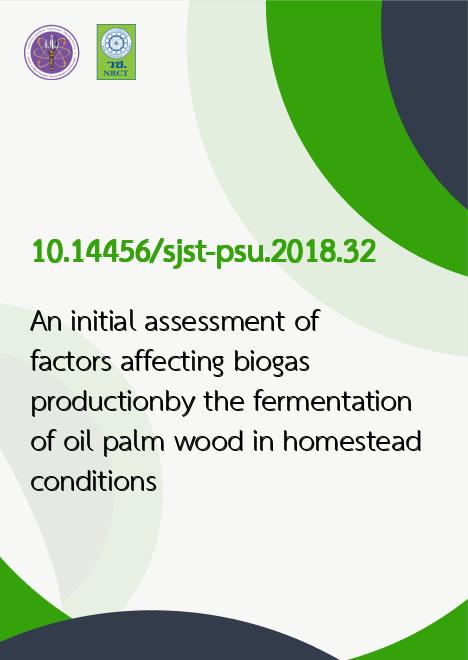
|
An initial assessment of factors affecting biogas productionby the fermentation of oil palm wood in homestead conditions |
|---|---|
| รหัสดีโอไอ | |
| Creator | 1. Nitas Proukaew 2. Suchada Inpan 3. Atita Phetphirun |
| Title | An initial assessment of factors affecting biogas productionby the fermentation of oil palm wood in homestead conditions |
| Publisher | Research and Development Office, Prince of Songkla University |
| Publication Year | 2561 |
| Journal Title | Songklanakarin Journal of Science and Technology |
| Journal Vol. | 40 |
| Journal No. | 2 |
| Page no. | 418 |
| Keyword | palm oil tree, biogas production, methanogen, temperature, C/N ratio |
| URL Website | http://rdo.psu.ac.th/sjstweb/index.php |
| ISSN | 0125-3395 |
| Abstract | Wood from a dead palm tree was studied for its suitability to methane production. Ground wood samples of 3 kg wereprocessed in fermentation tanks (plain sample in tank A). The gas was accumulated and measured over 30 days. Similar groundwood sample was put in another tank, also inoculating this with methanogen microbes (tank B), and the fermentation wascompared to similar with cow dung as the substrate (tank C). The dependence of methane production on environmentalconditions was also examined. The varied fermentation parameters were temperature, pretreatment of the substrate, and C/Nratio. It was found that tank C produced the largest amount of gas (4,125 cm3) followed by tank B (3,345 cm3), and finally tank A(2,010 cm3). Varying the fermentation temperature from high (outdoors) to medium (room temperature) and low (air conditionedroom) gave about similar accumulated gas amounts in the range 1,865-2,010 cm3. Pre-treatment of the substrate with alkaline(NaOH) produced more methane, about 2,412 cm3, while pre-treatment with acid (1% HCl) gave about 1,936 cm3 produced gas,which was equal to fermentation without pretreatment. The gas production further increased to about 2,702 cm3 when nitrogen(ammonium phosphate) was added to the system, and was only about 1,314 cm3 when the C/N ratio was raised by addingmolasses. The use of palm wood waste as substrate for biogas production is thus possible, but it should be fermented withinoculated methanogens, pre-treated with alkali, and the C/N ratio should be adjusted by adding nitrogen. |
